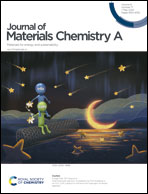Work function and band alignment of few-layer violet phosphorene†
Abstract
Violet phosphorene, a recently produced elemental 2D material, is a promising electronic and optoelectronic structure. The work function and band alignment of phosphorene nanoflakes are essential for their heterojunction structure design. The work function of violet phosphorene nanoflakes has been shown to decrease with the increase in layers from 5.16 eV to 4.79 eV and tends to be stable on a gold substrate, which has been confirmed via Kelvin probe force microscopy. The work functions measured on a silicon oxide substrate are much higher due to charge accumulation. The experimental work function of few-layer violet phosphorene is different from the intrinsic work function due to substrate doping, while that of thick violet phosphorene nanoflakes approaches the intrinsic work function value. Various functionals have been adopted for the work function calculation of few-layer violet phosphorene and the values obtained have been compared to the experimental results. The band alignments of different layered violet phosphorene materials calculated using the most accurate functional are demonstrated and compared to those of well-known materials to give a practical route for future applications. The work functions of the violet phosphorene nanoflakes have been shown to decrease due to oxidation, but they significantly improve after annealing in an argon atmosphere.



 Please wait while we load your content...
Please wait while we load your content...